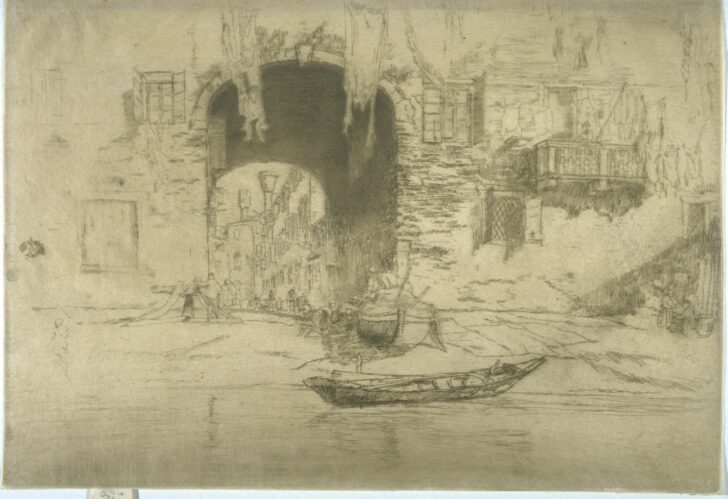San Biagio, One of the ‘Twenty-six Etchings’ or the ‘Second Venice Set’
James Abbott McNeill Whistler

Description
San Biagio, from Twenty-six Etchings, or the
Second Venice Set
1879–80
Etching and drypoint
Ninth state of nine (Kennedy 197)
Bequest of Margaret Watson Parker, 1954/1.385
The low vantage point here suggests that Whistler may have been working from a boat—as he frequently did. An old gondolier was hired to help him locate the “bits of strange architecture, windows, piles, balconies, queer water effects, canal views with boats—very rarely figure subjects” that became his personal iconography of Venice. With his prepared plates tucked between the leaves of a book to prevent abrasion and his sketching materials loaded in the bottom of the gondola, Whistler could traverse the back canals and streets either by boat or on foot with the gondola following behind him, seeking out exquisite images to record.
In San Biagio, the passageway from the canal into the street beyond takes on the stature of a triumphal arch. The composition is reduced to its essentials: the focal point of the arch and flanking windows and balcony that punctuate the wall are balanced in the foreground by the two boats, one pulled up on shore, the other along the water’s edge. The dark barrel vault leading into the distance is prevented from overwhelming the delicate balance of the surrounding details and the hanging laundry breaks up the mass of the passageway, visually eroding it with the ghostly forms of hanging shirts. The play of light over the old brick and stone of the outer wall are masterful, and the plate tone in the water gives this work a powerful stillness and quiet lyricism—a beauty that Whistler described in a letter to his mother: “after the wet, the colours upon the walls and their reflections in the canals are more gorgeous than ever—and with sun shining upon the polished marble mingled with rich toned bricks and plaster, this amazing city of palaces becomes really a fairy land—created one would think especially for the painter.”
-------
March 28, 2009
In 1879, Whistler received a commission from the London-based Fine Art Society for a set of twelve etchings of Venice. Initially intending to spend only two months in Venice, he returned to England thirteen months later with fifty etchings, ninety pastels, and more than a dozen paintings. His first residence in Venice was a palazzo along the Grand Canal, but straightened finances forced him to move to a less expensive part of town, near the church of San Biagio. Whereas traditional views of Venice focus on grand public spaces, Whistler found the shadowy side streets and canals more alluring. This view near San Biagio demonstrates the artist’s keen ability to capture the essentials quickly with a focus on the principal objects of interest, an approach he called “the secret of drawing.” Here, the essential object is the deeply shadowed arch that leads from the canal into a distant back street. Whistler uses minimal linework to anchor the peripherals of the image—the boats, the stonework of the walls and balcony, and the buildings seen beyond the arch. He minimizes the dark mass of the arch by the placement of the laundry that hangs in front of it, ghostly presences that erode the visual integrity of the architectural structure.
Subject Matter:
Whistler lived in the San Biagio area and the less frequented district of Venice provided him with rich subject material. The Glasgow catalogue raisonné identifies the arch as the Sotoportego de le Colone, San Bioagio, in Cannaregio, Venice.
Physical Description:
A large, two-story arched passageway leads from the foreground to a distant street. Viewed from the water of the canal that runs across the bottom of the print, the composition concentrates on the dark barrel vault of the passage, the boats that occupy the foreground between the water and the walls of the building, and windows and balconies that animate the wall on either side of the archway.
Usage Rights:
If you are interested in using an image for a publication, please visit https://umma.umich.edu/request-image/ for more information and to fill out the online Image Rights and Reproductions Request Form.